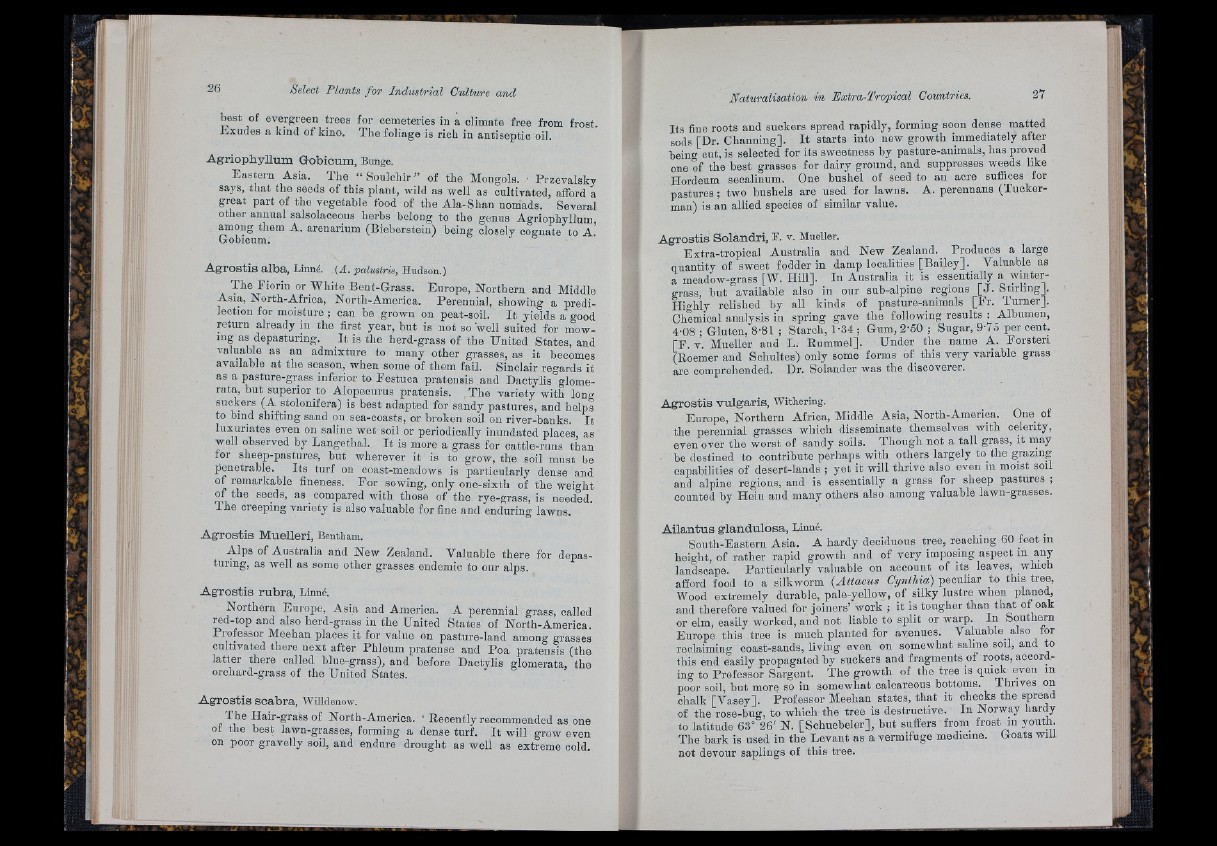
best of evergreen trees for cemeteries in a climate free from frost.
Exudes a kind of kino. The foliage is rich in antiseptic oil.
A g rio p h y llum G o b icum , Bunge.
Eastern Asia. The “ Soulchir” of the Mongols. ■ Przevalsky
says, th a t the seeds of this plant, wild as well as cultivated, afford a
great part of the vegetable food of the Ala-Shan nomads. Several
other annual salsolaceous herbs belong to the genus Agriophyllum
among them A. arenarium (Bieberstein) being closely cognate to A.’
Gobicum. ”
A g ro s t is a lb a , Linné. (A. palustris, Hudson.)
The Florin or White Bent-Grass. Europe, Northern and Middle
Asia, North-Africa, North-America. Perennial, showing a predilection
for moisture ; can be grown on peat-soil. I t yields a good
return already in the first year, but is not so well suited for mowing
as depasturing. I t is the herd-grass of the United States, and
valuable as an admixture to many other grasses, as it becomes
available a t the season, when gome of them fail. Sinclair regards it
as a pastiire-grass inferior to Pestuca pratenais aud Dactylis glome-
rata, but superior to Alopecurus pratensis. The variety with lono-
suckers (A stolonifera) is best adapted for sandy pastures, and helps
to bind shifting sand on sea-coasts, or broken soil on river-banks. I t
luxuriates even on saline wet soil or periodically inundated places, as
well observed by Langethal. I t is more a grass for cattle-runs than
for sheep-pastures, but wherever it is to grow, the soil must be
penetrable. Its turf on ooast-meadows is particularly dense and
of remarkable fineness. F o r sowing, only one-sixth of the weight
of the seeds, as compared with those of the rye-grass, is needed.
The creeping variety is also valuable for fine and enduring lawns.
A g ro s tis M u e lle ri, Bentham.
Alps of Australia and New Zealand. Valuable there for depasturing,
as well as some other grasses endemic to our alps.
A g ro s tis ru b r a , Linné.
Northern Europe, Asia and America. A perennial grass, called
red-top and also lierd-grass in the United States of North-America.
Professor Meehan places it for value on pastiire-land among grasses
cultivated there next after Phleum pratense and Poa pratensis (the
latter there called blue-grass), and before Dactylis glomerata, the
orchard-grass of the United States.
A g ro s tis s c a b r a , Willdenow.
The Hair-grass of North-America. " Recently recommended as one
of the best lawn-grasses, forming a dense turf. I t will grow even
on poor gravelly soil, and endure drought as well as extreme cold.
Its fine roots and suckers spread rapidly, forming soon dense matted
sods [Dr. Channing]. I t starts into new growth immediately after
being out, is selected for its sweetness by pasture-animals, has proved
one of the best grasses for dairy ground, and suppresses weeds like
Hordeum seoaliuum. One bushel of seed to an acre suffices for
pastures; two bushels are used for lawns. A. perennans (Tuoker-
man) is an allied species of similar value.
A g ro s tis S o la n d ri, F. v. Mueller.
Extra-tropical Australia and New Zealand. Produces a large
quantity of sweet fodder in damp localities [Bailey]. Valuable as
a meadow-grass [W. Hill]. In Australia it is essentially a wmter-
grass, but available also in our sub-alpine regions [ J . Stirling].
Highly relished by all kinds of pasture-animals [F r. Turner].
Chemical analysis in spring gave the following results : Albumen,
4-08 ; Gluten, 8'81 ; Starch, P34 ; Gum, 2'50 ; Sugar, 9 7 o per cent_.
[P . V. Mueller and L. Rummel]. Under the name A. Forsteri
(Rwmer aud Schultes) only some forms of^ this very variable grass
are comprehended. Dr. Solander was the discoverer.
A g ro s tis v u lg a r is , Withering.
Europe, Northern Africa, Middle Asia, North-America. One of
the perennial grasses which disseminate themselves with celerity,
even over the worst of sandy soils. Though not a ta ll grass, it may
be destined to contribute perhaps with others largely to the grazing
capabilities of desert-lands ; yet it will thrive also even in moist soil
and alpine regions, and is essentially a grass for sheep pastures ;
counted by Hein and many others also among valuable lawn-grasses.
A ila n tu s g la n d u lo s a , Linné.
South-Eastern Asia. A hardy deciduous tree, reaching 60 feet in
height, of rather rapid growth and of v e r y imposing aspect in a,ny
landscape. Particularly valuable on account of its leaves, wmcb
afford food to a silkworm (Atiacus Cynthia) peculiar to this tree,
Wood extremelv durable, pale-yellow, of silky lustre when planed,
and therefore valued for joiners’ work ; it is tougher than th a t of oak
or elm, easily worked, and not liable to split or warp. In Southern
Europe this tree is much planted for avenues. Valuable also for
reclaiming coast-sands, living even on somewhat saline soil, and to
this end easily propagated by suckers and fragments of roots, according
to Professor Sargent. The growth of the tree is q u i ^ even in
poor soil, but more so in somewhat calcareous bottoms. Thrives on
chalk [Vasey]. Professor Meehan states, th a t it checks the spread
of the rose-bng, to which the tree is destructive. In Norway hardy
to latitude 63° 26' N. [Schuebeler], but suffers from frost m youth.
The bark is used in the Levant as a vermifuge medicine. Goats will
not devour saplings of this tree.